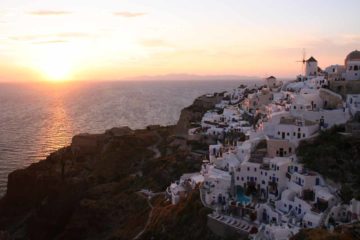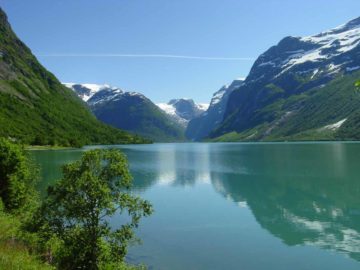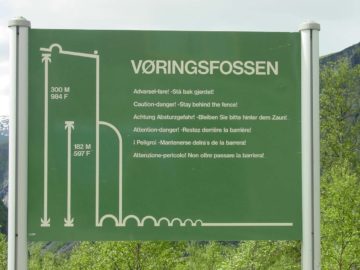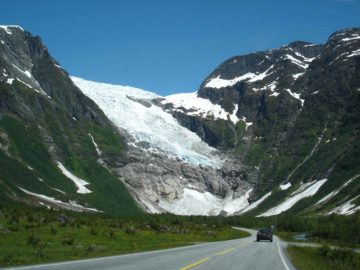About “Kjeragfossen”
“Kjeragfossen” was pretty much the main waterfall that I associate with the epic hike to the rock wedged between two vertical cliffs known as Kjeragbolten or often just Kjerag.
Of the numerous waterfalls that we encountered through Norway, perhaps none can boast such a beautiful position as I managed to see it framed with the gorgeous Lysefjord.
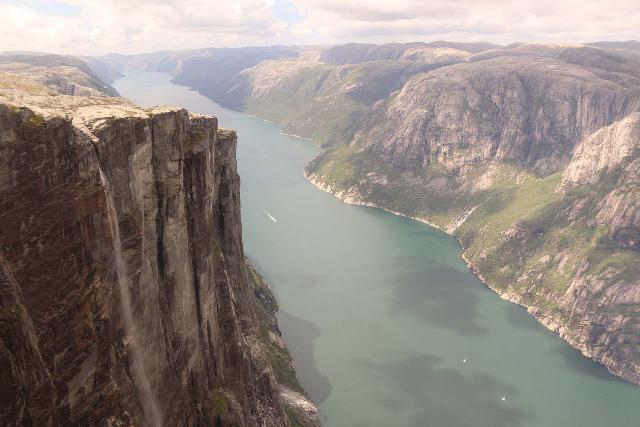
In fact, even when I made it to the Kjeragbolten, I managed to see the waterfall with base jumpers plunging beside the waterfall’s wispy vertical drop.
Indeed, as you can see in the photo above (and throughout this page for that matter), I could totally see why Kjerag became a worldwide Instagram favorite over the years.
And this waterfall forced me to partake in this epic hike so it made for the perfect excuse to do it!
A Special Waterfall?
You may have noticed that on this page, I put the word “Kjeragfossen” in quotes because I don’t believe it has a formal name.
In fact, from what I can tell on Norgeskart, it sits on an unnamed stream draining snow and tarns sitting on the plateau above Kjerag.
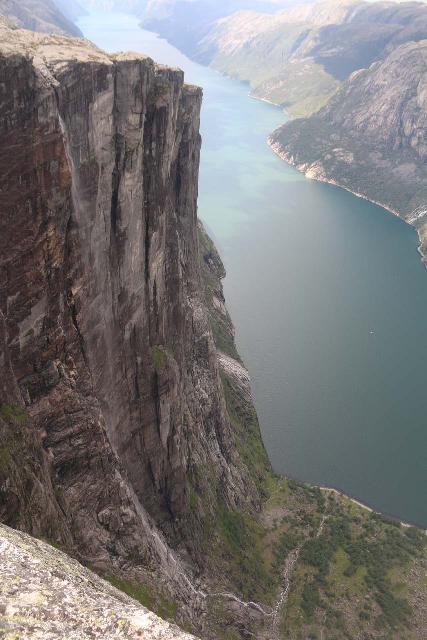
So that makes me question whether this waterfall flows permanently or merely has a seasonal Spring- to early-Summer flow.
Based on what I can see from the topo information on that map, this waterfall could very well have around a 525m freefall.
The rest of the elevation loss to sea level appeared to be a long cascade where the first 250m of the elevation loss could be steep cascades that might add to the freefall total.
However, the rest of the remaining 150m of elevation loss appeared to just be a sloping stream eventually settling at the Lysefjord at sea level.
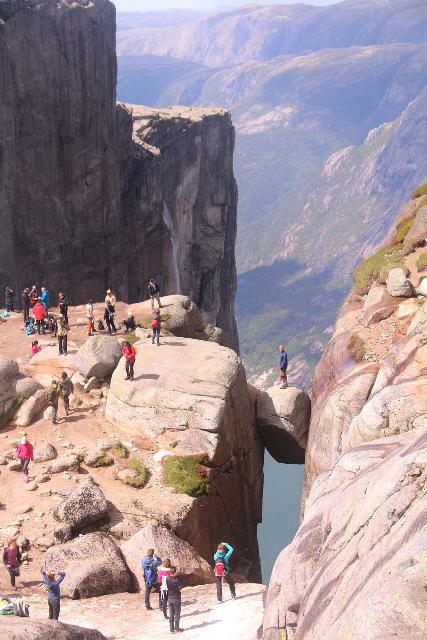
In any case, there could be other waterfalls in the immediate area that may have similar or greater flow than “Kjeragfossen”.
That said, I think this one gets the publicity simply because just about all intrepid hikers making it out to the famous Kjerag get to see this waterfall in action.
So I consider it gets singled out (like I did here) simply due to its fortunate location.
Hiking to Kjerag and Witnessing “Kjeragfossen”
Like with the other famous Lysefjord attraction at Preikestolen, Kjerag has become an international attraction.
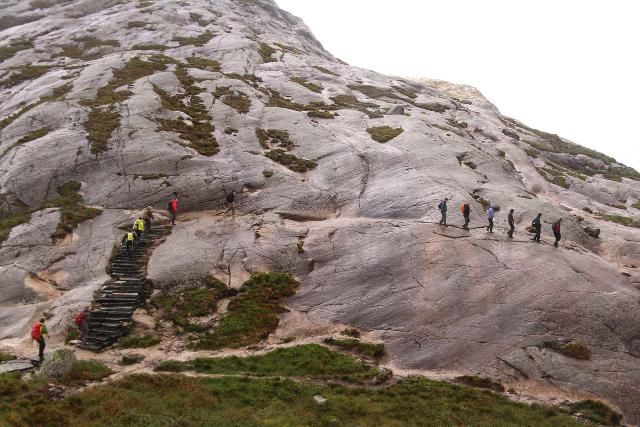
That means you can expect to share the trail with thousands of other tourists from around the world.
While the crowds may undermine the difficulty of this hike, in my experience, you really can’t underestimate what you sign up for when you do it.
That means you need to have proper hiking boots, layers of clothing due to the changeable weather (it was pouring rain when I started the hike before going sunny), a change of socks (for blister prevention), and plenty of food and water.
Indeed, this hike is 10km round trip with a net elevation gain of 380m (i.e. well over 1,200ft).
Much of the terrain involved hiking on unforgiving granite with plenty of dropoff exposure as well as chains to hold onto to help with the steepness and slick footing.
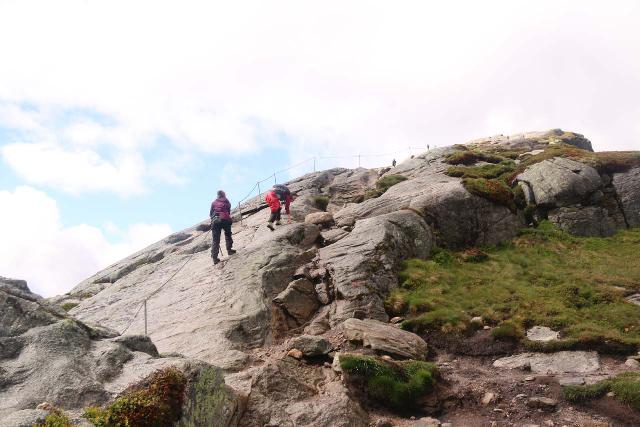
According to the signage, they suggest that the hike takes about 5 hours.
In my experience, it took me a little over 7 hours, which included not only experiencing Kjerag, but I also stopped at the panorama of Lysefjorden at Nesatind, and I also had a long lunch break.
Therefore, nothing about this hike should be taken lightly, and you really do need an early start to ensure you don’t hike in darkness if you happen to be outside the early Summer season.
Hiking to Kjerag and Witnessing “Kjeragfossen”: The Brutal Initial Climb
The Kjerag hike began at the car park at Øygardstølen at 640m in elevation (see directions below).
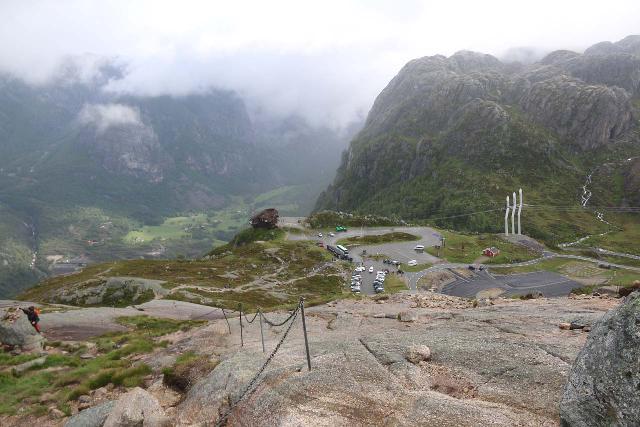
Right from the get-go, the trail immediately embarked on the first (and arguably the steepest and most challenging) of the three main climbs to realize the total elevation gain involved.
It ascended slick granite terrain with a combination of red Ts and cairns to help navigate me through some of the head-scratching moments.
In addition to aiding in stability and footing, chains also served as trail markers since I knew where I needed to go once I saw them.
Some granite steps had also been carved into the plateau to further help with footing and trail definition.
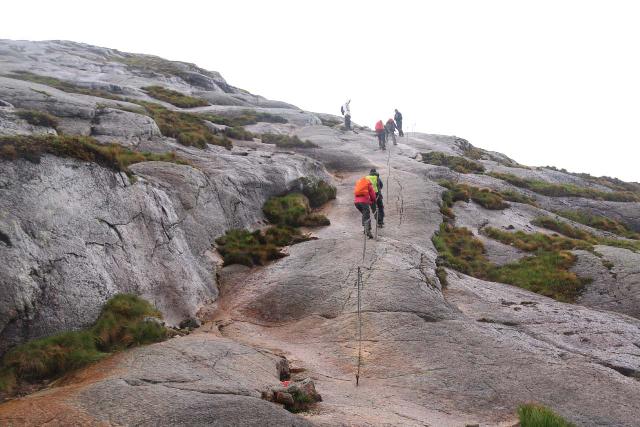
I knew immediately in this stretch of unforgiving sloping granite that hiking boots were an absolute necessity.
Tempering the physical challenge and concentration of this initial brutal climb were the mindblowing views as I ascended higher above the gorge over Lysebotn and Lysefjorden.
It took me nearly an hour to complete this kilometer-long, 185m high initial climb before the trail momentarily peaked.
Hiking to Kjerag and Witnessing “Kjeragfossen”: Ascending Above Litle Stordalen
Immediately after the initial climb, the trail descended into Litle Stordalen (literally translated as “The Little Big Valley”).
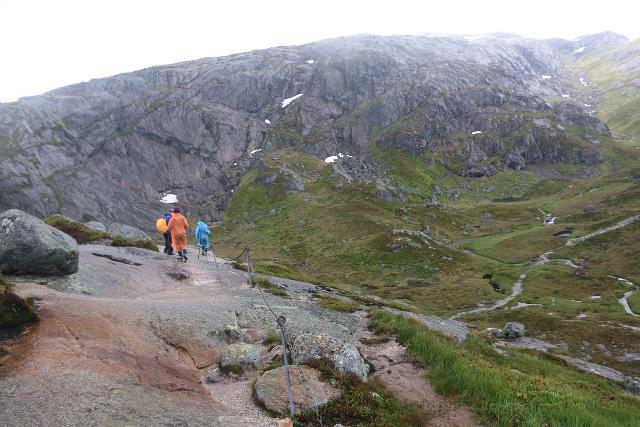
Again, I needed to use the chains provided to help with some of the dicier parts of the descent covering roughly 75m of elevation loss.
I often found it helpful to descend “backwards” while holding onto the chains for better footing on the slick granite.
Once within Litle Stordalen, I traversed a green area full of grass or moss-like growths on the granite surface.
Granite stones comprised the trail through this valley so I didn’t get any relief in terms of my knees getting jarred by the impact of every step I took.

Beyond the momentary flatness of Litle Stordalen, the trail then made its next ascent, which spanned about 500m with an elevation gain of roughly 150m or so.
Like with the initial climb, it started off with granite steps before degenerating into granite scrambles with some mild dropoff exposure.
Chains didn’t seem as prevalent in this stretch of the hike, but that didn’t make this ascent any less steeper than the first ascent.
That said, the ascent afforded me more views towards Lysebotn as well as some of the cascades at the head of Litle Stordalen.
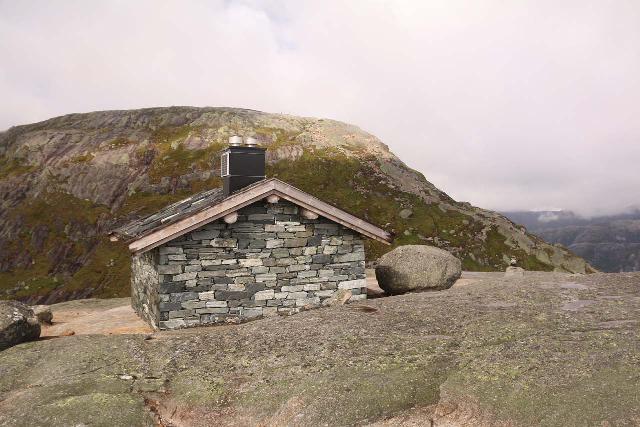
By the time I made it to the top, I encountered a momentary flat stretch that housed an emergency shelter or cabin (hytt) of some sort.
The shelter sat about 1km from the top of the previous climb, and about 2km from Øygardstølen with an overall elevation gain of 250m.
Hiking to Kjerag and Witnessing “Kjeragfossen”: Ascending Above Stordalen
Beyond the cabin, the trail descended perhaps 40-50m leading to the top of a cascade or waterfall draining some unnamed lake or tarn.
Contrary to its name, Stordalen seemed to be quite a bit smaller than Litle Stordalen as the third and final main climbing phase started shortly after crossing the stream running through the tiny valley.
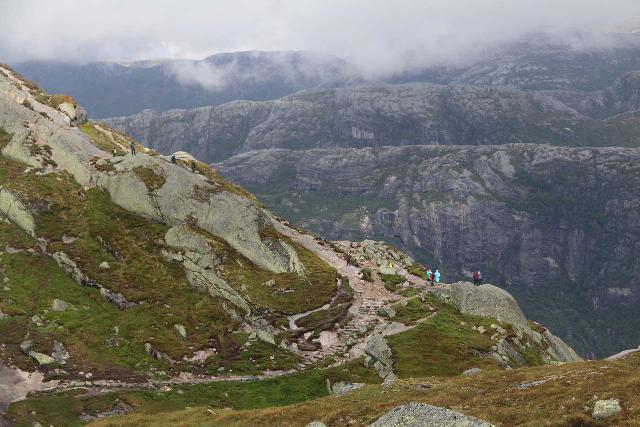
Like the first climb, this third climb involved more granite steps soon giving way to many long stretches of chains to help with the granite’s steep slopes.
The scenery around this climb continued to produce mindblowing views of Lysebotn and the head of Lysefjorden.
At these lofty heights, it really started to feel like I was on top of the world as my eyes almost seemed level with many of the surrounding peaks and knobs.
The steepest and worst of the climbing perhaps ended at around 1.2km or so beyond the cabin. However, the climbing didn’t end there.

Indeed, the train continued to ascend long past the last of the chains as the inclined gradually leveled out and I started to traverse an extensive granite plateau.
Once on the plateau, the terrain undulated through mini-gullies, but for the most part, it was mostly flat.
This type of scenery persisted for the next kilometer or so before I finally started to encounter signs marking trail junctions.
At this point, I had a choice of pursuing Nesatind to my right or continuing straight to pursue Kjerag on the left.
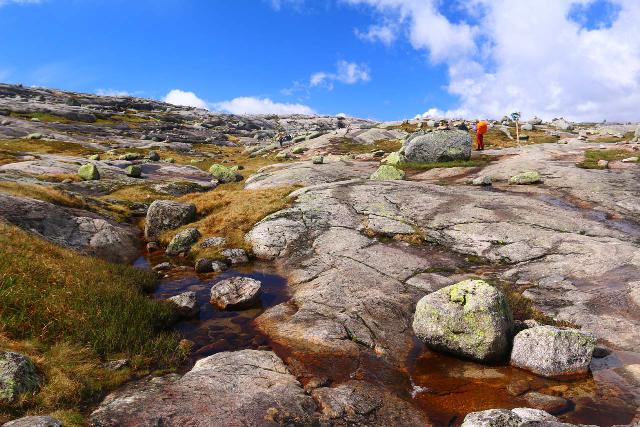
I opted to continue straight to Kjerag and then do Nesatind afterwards.
Hiking to Kjerag and Witnessing “Kjeragfossen”: Descending to Kjeragbolten
Barely 160m beyond the signed trail junction on the plateau, the trail then started to disappear into a gorge or narrow.
It turned out that I had a choice of descending into that narrow to get to Kjerag or stay on the rim of the narrow on the right to get to Nesatind.
Again, I opted to go into the narrow to keep going to the main attraction – Kjeragbolten.
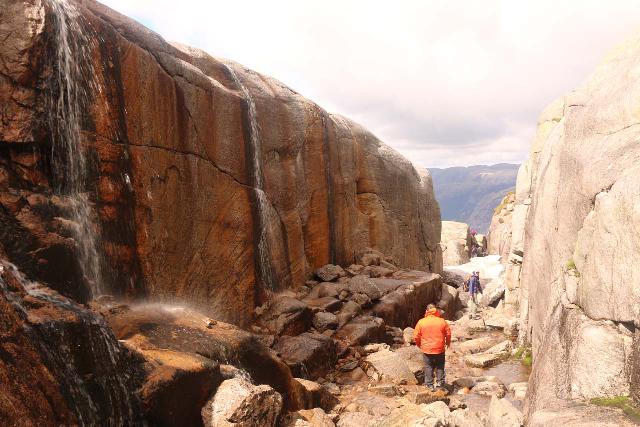
This narrow involved some mild scrambling and bouldering as I noticed giant boulders wedged and arranged to form obstacles.
For the most part, getting through these obstacles weren’t too bad though I definitely had moments where my day pack had rubbed against adjacent gorge walls or boulders.
I had also noticed a trio of segmented snowmelt cascades spilling right into the narrow.
Shortly beyond the cascades, the trail then descended right to the classic view of the famous Kjeragbolten though I had to contend with some packed snow when I had made my visit.
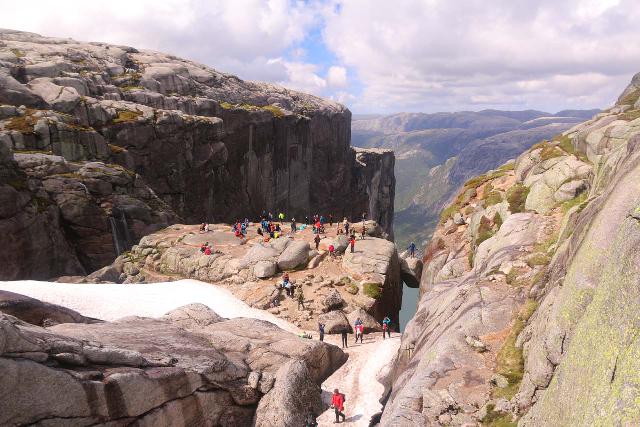
Most people manage to coordinate with a fellow member of the party to handle the camera while the other person would go towards the backside of Kjeragbolten to queue up to wait to go on top of the rock.
Speaking of the queue, there was a fairly extensive plateau adjacent to the backside of Kjeragbolten, and this was where most of the day hikers had stopped to enjoy the partial views of “Kjeragfossen” as well as the Lysefjorden further below.
I also noticed another thin waterfall spilling into another notch on the far side of the plateau.
There also seemed to be a waterfall right beneath the Kjeragbolten apparently draining the packed snow that I had just walked on earlier to get here.
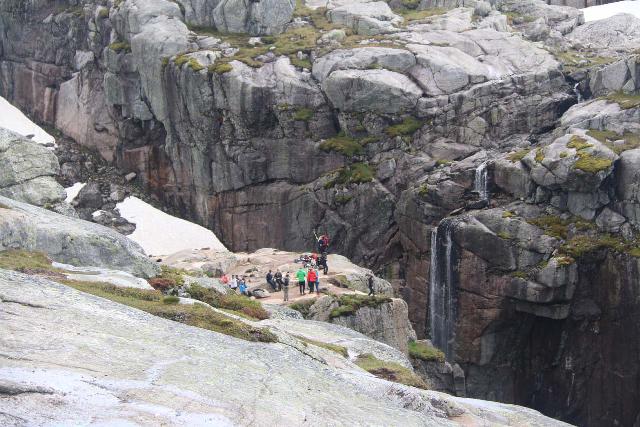
The trail signage suggested that this marked the 5km point of the hike, and most people turned around here to go back – apparently content with their top-of-the-rock photo and sharing on socials.
It took me a little less than 3 hours to get here from the trailhead.
Hiking to Kjerag and Witnessing “Kjeragfossen”: Scrambling to Nesatind
Although most people contented themselves with going back to the trailhead at this point, viewing the “Kjeragfossen” from here left me wanting more.
So after having my fill of the Kjeragbolten, I returned back through the narrow to its start.
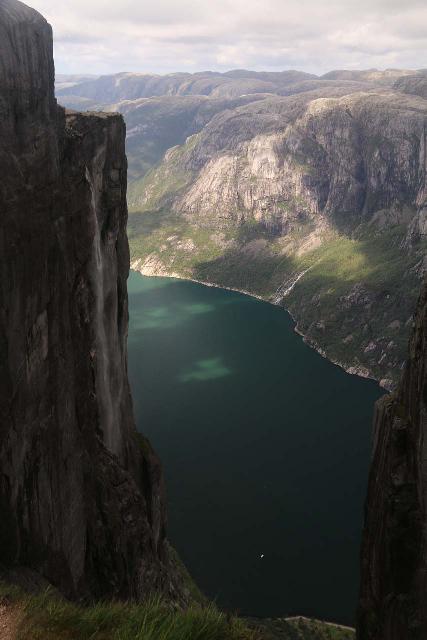
Then, I veered from the main trail and went left along the rim of the narrow, where I followed faint trails of use.
I don’t think this approach was sanctioned, but there were enough use trails to follow along and ultimately make it to the edge of the plateau at Nesatind.
This scramble was around 300-400m beyond the start of the narrow to Kjeragbolten, and I didn’t experience any significant elevation change to get here.
Along the way, I could look back towards Kjeragbolten and immediately see how the vast majority of hikers crowded themselves onto the plateau adjacent to Kjeragbolten.
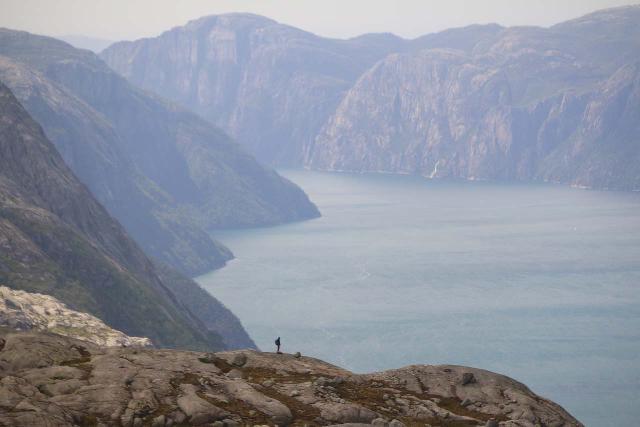
Meanwhile, the path I took felt refreshingly quiet and peaceful.
Anyways, as for the view itself, I personally liked the view here better than the Kjerag experience.
I felt like this view possessed a signature view over the waters of Lysefjorden, and the “Kjeragfossen” framed the panoramic view to boot!
Of course, I also had to watch out for dropoffs because trying to view the bottom of both the falls and the shores of the fjord (where base jumpers looking very tiny would land) involved getting uncomfortably close to the cliff edges.
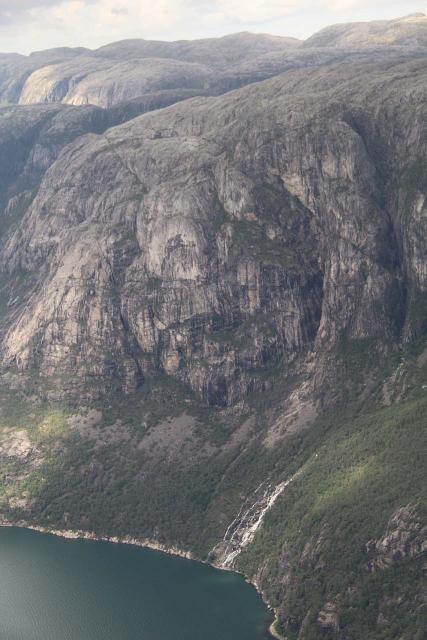
After having my fill of this panorama, then I followed some red Ts and cairns back towards the main trail.
According to my GPS logs, I went about 380m to get to a Nesatind sign, and I went another 160m to reach the sign on the plateau back at the main trail.
The rest of the way back to the trailhead was pretty straightforward.
However, because it was mostly downhill on the way back, I had to watch my footing, especially with my joints feeling some pain from the hard surfaces and fatigue starting to set in.
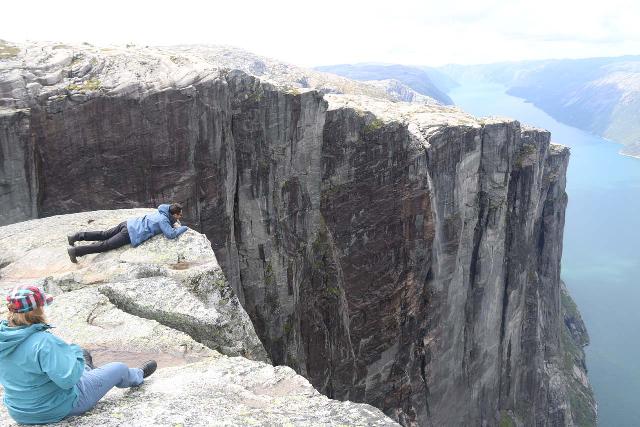
In one steep stretch on the return hike near the end, I did manage to slip backwards, but luckily my day pack broke my fall, and I landed on my feet as if nothing had happened.
That ought to underscore how at any moment, an accident can occur that could cause injury.
Authorities
“Kjeragfossen” (as well as the Kjeragbolten itself) sat in the Forsand Municipality in Rogaland County. For information or inquiries about the area as well as current conditions, visit the local government website.
Related Top 10 Lists
No Posts Found
Trip Planning Resources
Nearby Accommodations
This content is for members only. See Membership Options.Featured Images and Nearby Attractions
This content is for members only. See Membership Options.Visitor Comments:
Got something you'd like to share or say to keep the conversation going? Feel free to leave a comment below...No users have replied to the content on this page
Visitor Reviews of this Waterfall:
If you have a waterfall story or write-up that you'd like to share, feel free to click the button below and fill out the form...No users have submitted a write-up/review of this waterfall


